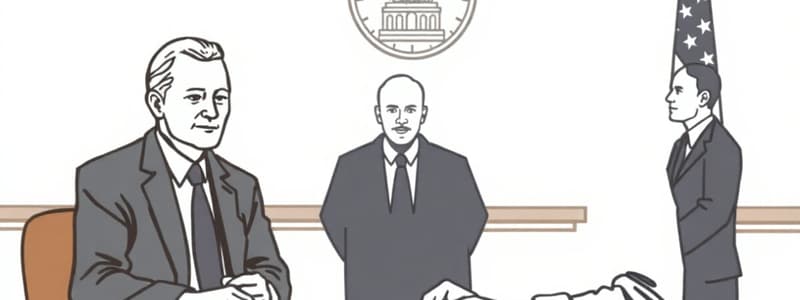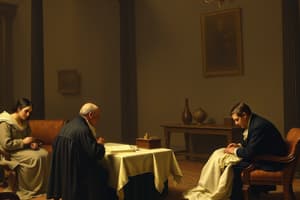Podcast
Questions and Answers
What is the primary purpose of a civil service system that emphasizes merit-based hiring?
What is the primary purpose of a civil service system that emphasizes merit-based hiring?
- To ensure all government jobs are filled by individuals from politically connected families.
- To increase the influence of political parties in government administration.
- To create more opportunities for short-term, contract-based government employment.
- To reduce political patronage and ensure government positions are filled by qualified individuals. (correct)
How did the Pendleton Act of 1883 contribute to the development of the modern bureaucracy?
How did the Pendleton Act of 1883 contribute to the development of the modern bureaucracy?
- By establishing term limits for civil servants.
- By legalizing political patronage at the federal level.
- By creating a spoils system to reward political allies.
- By mandating merit-based hiring to reduce political patronage. (correct)
What is the main purpose of the Hatch Acts of 1939 and 1940?
What is the main purpose of the Hatch Acts of 1939 and 1940?
- To provide financial incentives for federal employees who volunteer in political campaigns.
- To restrict the political activities of federal employees, ensuring non-partisanship. (correct)
- To encourage federal employees to actively participate in political campaigns.
- To allow federal employees to run for any political office without restrictions.
Why did Woodrow Wilson advocate for a professional and efficient government bureaucracy?
Why did Woodrow Wilson advocate for a professional and efficient government bureaucracy?
What is the purpose of sunshine laws?
What is the purpose of sunshine laws?
What is 'agency capture,' and why is it problematic?
What is 'agency capture,' and why is it problematic?
What is the 'bully pulpit' and how does the President use it?
What is the 'bully pulpit' and how does the President use it?
What is the main purpose of the President’s annual State of the Union address?
What is the main purpose of the President’s annual State of the Union address?
Explain the function of an executive order.
Explain the function of an executive order.
What does it mean for the President to act as 'Commander-in-Chief'?
What does it mean for the President to act as 'Commander-in-Chief'?
What is the significance of the Senate's 'advice and consent' role in the appointment of federal officials?
What is the significance of the Senate's 'advice and consent' role in the appointment of federal officials?
Which of the following is a primary function of the legislative branch?
Which of the following is a primary function of the legislative branch?
What is legislative oversight?
What is legislative oversight?
What is the function of a filibuster in the Senate?
What is the function of a filibuster in the Senate?
What is the role of a conference committee in the legislative process?
What is the role of a conference committee in the legislative process?
What is 'gerrymandering,' and what is its primary effect?
What is 'gerrymandering,' and what is its primary effect?
What was the primary goal of Progressive reforms in the early 20th century?
What was the primary goal of Progressive reforms in the early 20th century?
How did Progressive reforms affect the American middle class?
How did Progressive reforms affect the American middle class?
What was the principal outcome of the disputed election of 1876 between Rutherford B. Hayes and Samuel J. Tilden?
What was the principal outcome of the disputed election of 1876 between Rutherford B. Hayes and Samuel J. Tilden?
What does the 25th Amendment address?
What does the 25th Amendment address?
Flashcards
Civil Service System
Civil Service System
Hiring and promoting government employees based on skills and ability, not political connections.
Merit System
Merit System
A system where job positions are awarded based on an individual's demonstrated abilities and qualifications.
Pendleton Act of 1883
Pendleton Act of 1883
Legislation that mandated merit-based hiring in the federal government to reduce political influence.
Hatch Acts of 1939 & 1940
Hatch Acts of 1939 & 1940
Signup and view all the flashcards
Weberian Bureaucracy
Weberian Bureaucracy
Signup and view all the flashcards
Sunshine Laws
Sunshine Laws
Signup and view all the flashcards
Agency Capture
Agency Capture
Signup and view all the flashcards
Head of State vs. Head of Government
Head of State vs. Head of Government
Signup and view all the flashcards
Symbolic Powers (Bully Pulpit)
Symbolic Powers (Bully Pulpit)
Signup and view all the flashcards
State of the Union
State of the Union
Signup and view all the flashcards
Executive Orders/Actions
Executive Orders/Actions
Signup and view all the flashcards
Commander-in-Chief
Commander-in-Chief
Signup and view all the flashcards
Appointment Powers
Appointment Powers
Signup and view all the flashcards
Pardon/Clemency/Commutation
Pardon/Clemency/Commutation
Signup and view all the flashcards
Advice and Consent
Advice and Consent
Signup and view all the flashcards
Lawmaking
Lawmaking
Signup and view all the flashcards
Oversight
Oversight
Signup and view all the flashcards
Constituent Services
Constituent Services
Signup and view all the flashcards
Filibuster
Filibuster
Signup and view all the flashcards
Reconciliation/Conference Committee
Reconciliation/Conference Committee
Signup and view all the flashcards
Study Notes
- Civil Service Systems hire and promote employees based on merit, not political connections
- The merit system emphasizes ability and qualifications
- The Pendleton Act of 1883 required merit-based hiring to curb political patronage
- The Hatch Acts of 1939 & 1940 limit federal employees' political activities to ensure impartiality
Bureaucratic Structure
- Weberian Bureaucracy uses a structured, hierarchical model focused on efficiency and rationality
- Woodrow Wilson supported a professional and efficient government bureaucracy
Sunshine Laws and Agency Regulation
- Sunshine Laws promote government transparency by opening meetings and records to the public
- Agency Capture occurs when a regulatory agency favors the interests of the industries it regulates over public interest
Presidency Functions
- The President is both the symbolic national representative (Head of State) and the main executive policymaker (Head of Government)
- Presidents use the "bully pulpit" to persuade public opinion and Congress
- The State of the Union address informs Congress and sets policy goals annually
Executive Powers
- Executive Orders are used to manage the federal government and influence policy
- The President acts as Commander-in-Chief with control over military forces
Appointments and Legal Powers
- The President can appoint federal officials, often requiring Senate confirmation
- The President has powers of Pardon, Clemency, and Commutation to forgive crimes and reduce punishments
- Advice and Consent requires Senate approval for treaties and appointments
Congressional Functioning
- Congress introduces, debates, amends, and votes on bills to create laws
- Congress can oversee and investigate the executive branch
- Congress serves local interests and represents public interests through Constituent Services
Legislative Processes
- A Filibuster delays or prevents a vote on a bill through extended speaking
- Reconciliation/Conference Committees reconcile differences in bills passed by both chambers
Electoral and Political Actions
- Earmarks/Pork direct funds to specific projects or regions
- Gerrymandering manipulates district boundaries to favor a party
- Reapportionment adjusts seats, and redistricting redraws boundaries based on population changes
Progressive Reforms
- Progressive Reforms aimed to address social, political, and economic issues and regulate corporations
- These reforms sought to improve conditions for the middle class by addressing working conditions and enforcing fair business practices
Historical Context
- The disputed election of 1876 between Hayes and Tilden led to a compromise that influenced future political protocols
Amendments
- The 12th Amendment established separate electoral votes for President and Vice-President
- The 22nd Amendment limits presidents to two terms
- The 25th Amendment outlines presidential succession and vice-presidential vacancy procedures
Studying That Suits You
Use AI to generate personalized quizzes and flashcards to suit your learning preferences.




